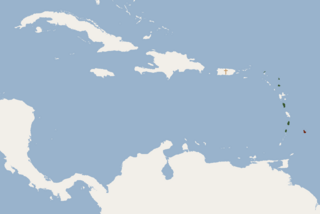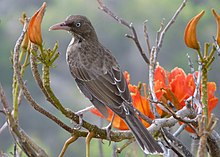
The Lesser Antilles are a group of islands in the Caribbean Sea. They are distinguished from the large islands of the Greater Antilles to the west. They form an arc which begins east of Puerto Rico and swings south through the Leeward and Windward Islands almost to South America and then turns west along the Venezuelan coast as far as Aruba. Barbados is isolated about 100 miles east of the Windwards.

The mimids are the New World family of passerine birds, Mimidae, that includes thrashers, mockingbirds, tremblers, and the New World catbirds. As their name suggests, these birds are notable for their vocalization, especially some species' remarkable ability to mimic a wide variety of birds and other sounds heard outdoors. They are commonly referred to as mimic thrushes but are not, in fact, thrushes.

Thrashers are a New World group of passerine birds related to mockingbirds and New World catbirds. Like these, they are in the family Mimidae. There are 15 species in one large and 4 monotypic genera.

The Antilles is an archipelago bordered by the Caribbean Sea to the south and west, the Gulf of Mexico to the northwest, and the Atlantic Ocean to the north and east.

The Leeward Islands are a group of islands situated where the northeastern Caribbean Sea meets the western Atlantic Ocean. Starting with the Virgin Islands east of Puerto Rico, they extend southeast to Guadeloupe and its dependencies. In English, the term Leeward Islands refers to the northern islands of the Lesser Antilles chain. The more southerly part of this chain, starting with Dominica, is called the Windward Islands. Dominica was originally considered a part of the Leeward Islands, but was transferred from the British Leeward Islands to the British Windward Islands in 1940.

The white-necked crow is the largest of the four Caribbean corvids. It is endemic to the island of Hispaniola ; it was formerly also extant on Puerto Rico, but has been extirpated there due to considerable forest clearance and hunting.

The Inter-American Division of Seventh-day Adventists is a sub-entity of the General Conference of Seventh-day Adventists, which oversees the Church's work in Mexico, Central America, the Caribbean, and Northern South America.

In geography, the Caribbean Basin or Caribbean Proper is generally defined as the Caribbean Sea and any territories in or touching the Caribbean Sea. This means countries like Barbados and The Bahamas, which are culturally and politically Caribbean, are not included.

The United Nations geoscheme for the Americas is an internal tool created and used by the UN's Statistics Division (UNSD) for the specific purpose of UN statistics.
The law of North America is diverse and influential. The law of the United States has worldwide renown, in its codified constitution, and bill of rights, while the law of Cuba differs vastly in its regulation of private property. The first court of justice was established in Newfoundland and Labrador, Canada in 1615 by Sir Richard Whitbourne as a court of admiralty at the future site of Trinity, Newfoundland and Labrador.

Tremblers (Cinclocerthia) are a genus of perching birds in the family Mimidae that are endemic to the Lesser Antilles. They are medium-small, mostly brown or grey birds with long beaks and tails that typically are held cocked. Most recent authorities recognize two species in the genus, but some split each into two species, bringing it to four species:

The Caribbean Tourism Organization's main objective is the development of sustainable tourism for the economic and social benefit of Caribbean people.

The brown trembler is a species of bird in the family Mimidae, the mockingbirds and thrashers. It is found on the islands of Saba, St. Kitts, Nevis, Montserrat, Guadeloupe, Dominica and St. Vincent in the Lesser Antilles of the Caribbean Sea.

The scaly-breasted thrasher is a species of bird in the family Mimidae. It is found throughout much of the Lesser Antilles of the Caribbean Sea.

The insular single leaf bat or Lesser Antillean long-tongued bat is a species of leaf-nosed bat. It is found on the Lesser Antilles islands in the Caribbean Sea.
The Caribbean bioregion is a biogeographic region that includes the islands of the Caribbean Sea and nearby Atlantic islands, which share a fauna, flora and mycobiota distinct from surrounding bioregions.

The Caribbean is a subregion of the Americas that includes the Caribbean Sea and its islands, some of which are surrounded by the Caribbean Sea and some of which border both the Caribbean Sea and the North Atlantic Ocean; the nearby coastal areas on the mainland are sometimes also included in the region. The region is south-east of the Gulf of Mexico and Northern America, east of Central America, and north of South America.
The Saint Lucia national football team represents Saint Lucia in international football under the control of the Saint Lucia Football Association (SLFA). Although a Saint Lucia representative team had played previously, the football association was founded in 1979. It became fully affiliated to CONCACAF in 1986 and joined FIFA two years later.


















